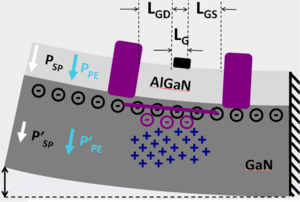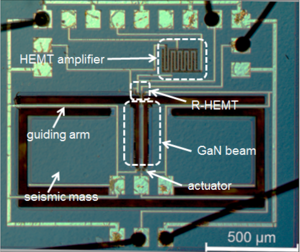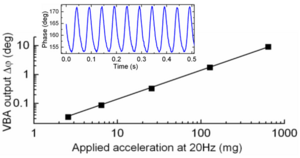
Didier Théron
Research axes
Instrumentation and characterization of materials at the nanoscale using scanning microwave microscopy (SMM)
IEMN, Univ. Lille, CNRS, UMR 8520 Christophe Morelle (Ph'D 2013 - 2016) Didier Théron (researcher at CNRS), Victor Zhang (researcher at CNRS), Lionel Buchaillot (researcher at CNRS), Bertrand Grimbert (engineer at U. Lille), Pascal Tilmant (engineer at CNRS), | IEMN, Univ. Lille, CNRS, UMR 8520 François Vaurette (engineer at CNRS), Isabelle Roch‑Jeune (engineer at CNRS), Virginie Brandli (engineer at CNRS), Vanessa Avramovic (engineer at CNRS), Etienne Okada (engineer at U. Lille), Marc Faucher (researcher at CNRS) | SOITEC Belgium, 3500 Hasselt, Belgium Joff Derluyn Stefan Degroote Marianne Germain |

Two main contributions related to the pyroelectric and piezoelectric properties of GaN and AlGaN allow the detection of the beam flexion.
First, at the AlGaN/GaN heterostructure interface, a two-dimensional electron gas arises from to the difference in spontaneous polarization between the two materials
When the beam vibrates, each material locally undergoes the same strain but the difference of piezoelectric properties between the two materials results in a difference of piezoelectric polarization. When the beam vibrates, each material undergoes the same deformation at the interface, but the difference in piezoelectric properties between the two materials leads to a difference in polarization, which induces a fixed electrical charge.
Secondly, when the beam vibrates, the entire GaN buffer layer generates a fixed charge whose density can be calculated by the divergence of the piezoelectric polarization field.
In both cases, to ensure electrical neutrality, the fixed polarization charges will be compensated by a free charge in the two-dimensional electron gas connected to the ohmic contacts shown in violet on the figure.

The accelerometer (see figure) is made by combining a resonant beam and a proof mass.
The devices are fabricated on an AlGaN/GaN heterostructure epitaxially grown on a silicon substrate. The device structure was initially optimized for HEMTs. GaN epitaxy on silicon can only be achieved at the cost of a residual stress in the GaN layer. This phenomenon, due to the mismatch in lattice parameters between GaN and Si and to the difference in the coefficient of expansion between the two materials, needs to be carefully controlled in order to release beams that are not deformed by buckling and whose resonant frequency can be reproducibly controlled. In addition, we need to be able to control the total thickness of the GaN layers, since they determine the thickness of the beams and their resonant frequency. Material growth research was carried out by the CRHEA under the supervision of Dr Yvon Cordier.
The resonator beam is released by chemical and plasma etching. The silicon substrate is also etched. The residual stress in the resonator allows detection by increasing or reducing the stress.
The test mass is released and held by four guiding arms. It is also connected to one end of the resonator (GaN beam). Here, the silicon substrate is retained to provide a sufficient mass.

To characterize the accelerometer, it is mounted on a “vibrating pot”, which is a support oscillating at a low frequency (20 Hz). The accelerometer response is obtained by measuring the phase of the resonator (GaN Beam) output signal as a function of time. The signal shows that the accelerometer is operational and that its response is proportional to the applied acceleration (figure). Further details can be found in the publications.
M. Faucher, B. Grimbert, Y. Cordier, N. Baron, A. Wilk, H. Lahreche, P Bove, M. François, P. Tilmant, T. Gehin, C. Legrand, M. Werquin, L. Buchaillot, C. Gaquière, and D. Théron, "Amplified piezoelectric transduction of nanoscale motion in gallium nitride electromechanical resonators", Appl. Phys. Lett. 94, 2009 pp. 233506. http://doi.org/10.1063/1.3153504
C. Morelle, D. Théron, I. Roch-Jeune, P. Tilmant, E. Okada, F. Vaurette, B. Grimbert, J. Derluyn, S. Degroote, M. Germain, and M. Faucher, “A micro-electro-mechanical accelerometer based on gallium nitride on silicon”, Appl. Phys. Lett. 122, 2023 pp. 033502. https://doi.org/10.1063/5.0127987 or https://hal.science/hal-03945292v1. Paper selected as an Editor’s Pick.



